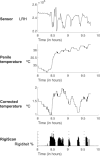Shedding light on night-time erections: Determining the feasibility of nocturnal erection detection with penile transdermal light reflection of haemoglobin
- PMID: 39323922
- PMCID: PMC11420100
- DOI: 10.1002/bco2.410
Shedding light on night-time erections: Determining the feasibility of nocturnal erection detection with penile transdermal light reflection of haemoglobin
Erratum in
-
Erratum.BJUI Compass. 2024 Dec 30;5(12):1324-1329. doi: 10.1002/bco2.482. eCollection 2024 Dec. BJUI Compass. 2024. PMID: 39744071 Free PMC article.
Abstract
Objectives: Utilizing penile saturation and temperature measurements presents a promising avenue for the development of an innovative sensor system aimed at nocturnal erection detection. This study aims to determine the feasibility of erection detection with light reflection of haemoglobin (LRH), as a precursor for penile saturation measurements, as well as penile temperature by comparison with simultaneous overnight RigiScan measurements.
Materials and methods: This is a proof-of-concept observational study on 10 healthy volunteers with a cross sectional design. A penile transdermal haemoglobin and temperature sensor was developed to measure penile LRH through real-time monitoring with receiving photodiodes and emitting light-emitting diode (LED). Besides statistical analysis on LRH, temperature and RigiScan data, a visual assessment was done to determine detectability of changes in the LRH and temperature course during the RigiScan-annotated erections.
Results: A total of 40 nocturnal erections from 10 healthy volunteers were annotated with the RigiScan. The LRH values significantly increase during a nocturnal erection (p < 0.01) and penile temperature (p < 0.01). The largest elevation of temperature was seen in the last erection, with an increase of 0.94°C. The corrected temperature shows an increase of 1.29°C in the last erection. Furthermore, visual detectability was feasible for 80% of the erections with LRH values and 90% with the temperature output.
Conclusion: Penile LRH and temperature have the potential to serve as an alternative methodology for nocturnal erection detection compared with the currently applied circumference and rigidity measurements. This is an important step in the development of a patient-friendly and modernized tool for erectile dysfunction diagnostics. An improved sensor should be developed to allow for calculation of saturation percentage from LRH values. In combination with penile temperature measurements, this allows for conduction of further validity studies to work towards translation into clinical practice for non-invasive ED diagnostics.
Keywords: RigiScan; erectile dysfunction; light reflection of haemoglobin; nocturnal erections; penile temperature.
© 2024 The Author(s). BJUI Compass published by John Wiley & Sons Ltd on behalf of BJU International Company.
Conflict of interest statement
The authors declare that they have no conflict of interest or competing financial interest.
Figures



References
-
- Impotence NIH. Consens conference. JAMA. 1993;270:83–90. - PubMed
-
- Schouten BWV, Bosch JLHR, Bernsen RMD, Blanker MH, Thomas S, Bohnen AM. Incidence rates of erectile dysfunction in the Dutch general population. Effects of definition, clinical relevance and duration of follow‐up in the Krimpen Study. IJIR. 2005;17:58–62. - PubMed
-
- Meuleman EJ, Donkers LH, Robertson C, Keech M, Boyle P, Kiemeney LA. Erectile dysfunction: prevalence and effect on the quality of life; Boxmeer study. Ned Tijdschr Geneeskd. 2001;145(12):576–581. - PubMed
LinkOut - more resources
Full Text Sources
